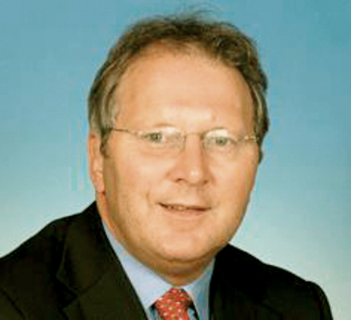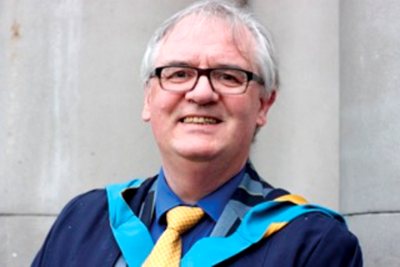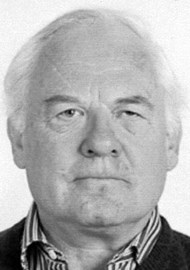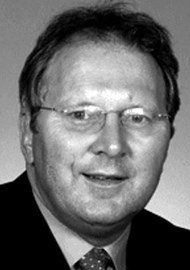Ray Clarke.
How did you get involved in the forthcoming Scott-Brown ? How does one become editor of a textbook?
Editors are approached and appointed by the publishers, but of course publishers will take advice and soundings from within the specialty. I had done some work on the last edition as section editor of the paediatric chapters under the leadership of Mike Gleeson. I knew how much toil and effort Mike had put in to it. It was a superb achievement, and I was proud to have played a small part in bringing it to fruition, but I thought that was the end of my involvement with Scott-Brown.
A few years later John Watkinson phoned me out of the blue and told me he had accepted the task of editing the new (8th) edition. I wished him well, and presumed he wanted some pointers as to how he might get help for the paediatric section. I was taken aback when he suggested I join him as co-editor. Needless to say I said no, mindful of the enormity of the task, but John convinced me that it was a gentle update rather than a whole new edition, and we would crack it very quickly. It gradually became clear that we had – as had every editor before us – underestimated the work ahead. I was in now and had to see it through! It is now 10 years since the last edition, so, far from an update, what was needed was a completely rewritten text.
We worked together on ENT & Audiology News for years. Did your role as Editor of ENT & Audiology News help?
Definitely. Working on ENT & Audiology News was fab, I thoroughly enjoyed it, but it was time to make way for someone new. I pined a bit for a long time after I left, I missed the adrenaline, the deadlines, the joy of seeing a new issue grow from a spark of an idea to a shiny beautifully produced magazine dropping on the doormat. Editing a magazine and editing a major textbook need very different skills but there is some overlap. Deadlines, recalcitrant authors, heart-sink text that needs to be completely revamped, missing illustrations, missing files, out of date references and seething (often with good reason!) authors are common to both! And the pleasure of seeing an idea grow into an outline plan, through early drafts and revisions into a beautiful polished and highly readable final chapter is a joy to both author and editor.
You have published a textbook of paediatric otolaryngology (Pediatric Otolaryngology – Practical Clinical Management, Thieme) and a couple of undergraduate texts (Lecture Notes in ENT and ENT at a Glance, Wiley). How different is Scott-Brown?
Oh hugely different in scale, they were relatively short books and I could do lots of the writing and all the editing myself. Scott-Brown is an enormous project and no-one could have expertise in all the topics covered. I depended on the skill, knowledge, and of course the contacts and professional networks of a team of section editors. They have been fabulous, they have given unstintingly of their time, put up with my quirky requests for rewrites, changes and more figures, my gentle prods re deadlines, and I hope have remained friends despite all the tribulations of working on such a big and often frustrating project essentially ‘pro-bono’. John and I are named as ‘Editors-in-Chief’ but in truth our job was to facilitate a superbly talented team. It is the energy, commitment and enthusiasm for imparting the knowledge and wisdom of section editors and authors that have brought this book about, John and I are essentially just the ‘midwives’.
How did you feel about the task when you finally agreed to take it on?
I used Scott-Brown throughout my career, and I know the reverence in which it is held. I was especially conscious that John and I were standing on the shoulders of the giants of the specialty who had gone before us – Scott-Brown himself, John Ballantyne, John Booth, Alan Kerr and more recently Mike Gleeson. So there was an element of awe, and of course a feeling of pride that we were custodians of this strong tradition of scholarship and learning that Scott-Brown had established for British otolaryngology. This was coupled with fear, trepidation and a degree of naivety about how much work needed doing, which probably helped!
“...the pleasure of seeing an idea grow into an outline plan, through early drafts and revisions into a beautiful polished and highly readable final chapter is a joy to both author and editor.”
Why has production been so delayed?
Health ministers used to make excuses for slow NHS improvements by talking of ‘turning the super-tanker around’! The analogy holds good for a large multi-volume text. Despite our best efforts, it just wasn’t easy to get such a vast number of chapters delivered in synchrony. Authors are busy, and almost all of the writing and editing is done by full-time clinicians who devote evenings, weekends, and sometimes annual leave to meeting deadlines. You might think that the huge advances in printing and publishing would speed things up, but there is still a laborious process. It takes a year or more between getting a text of this size edited and ready for production and actually getting the book on the stands. Publishing medical textbooks is not too profitable, margins are small, overheads high and the publishing industry is capricious. We had to live through a few changes of publisher and a few changes of personnel, all of which took their toll. Miranda Bromage at Taylor and Francis heads up the team at the publishers and she and her staff have been fabulous, so the long hard road is behind us now and we are on target for a launch at BACO International 2018 in Manchester.
What will be different from the last edition?
Almost everything has been completely rewritten. The specialty has changed out of all recognition in the last ten years. Thyroid and parathyroid surgery is now almost exclusively the domain of otolaryngologists, as is pituitary surgery, so we have a substantial section now on endocrine surgery put together by James England. Aesthetic facial surgery is now part of mainstream practice and is well covered by Nick White and Tim Woolford. Haytham Kubba, who was based in Melbourne until recently, has updated the paediatric ENT chapters.
There have been huge advances in the basic sciences, particularly genetics, as they relate to ENT, so Adam Donne and Louise Clark have revamped that section completely. Sean Carrie and Gerry McGarry have edited the rhinology chapters to reflect enormous advances in endoscopic surgical techniques. Terry Jones and Vin Paleri have revamped the oncology chapters to incorporate the rapid changes in aetiology, presentation and management of squamous carcinomas of the head and neck. Doris Bamiou’s audiological medicine section is hardly recognisable from the last edition, and Shak Saeed and Richard Irving have updated the skull base chapters to include advances in imaging and especially in what is almost a new subspecialty – implantation otology. Chris Aldren headed up the biggest section ‘Otology’ and heroically soldiered through it on his own.
Scott-Brown was traditionally ‘the best of British’. Is it more international now?
Yes, very much so. Email, wi-fi, social media, more international conferences and improved communication across political and territorial boundaries have made a big impact and I am delighted to welcome authors from a much wider geographical area than has been the case in previous editions. You can get a chapter in now from North America, work on it, send it back and have a revised version in your inbox ready for production in a single evening. This makes the whole process so much easier than it was for our predecessors, and endless faxes, telephone calls, bulky envelopes in the post and the celebrated editorial ‘red pen’ which caused authors so much angst are things of the past. We have several American authors, authors from across Europe and I am glad to say some from South Asia where Scott-Brown has always had strong support.
How will the 8th edition be better than before?
Well I am not going to be critical of past editions; each Scott-Brown has been better than the last, and we hope the next issue will be better still. Every editorial team puts their stamp on a new book. We have kept many of the features which made the last edition so successful, e.g. the ‘key points’ and summaries, but we have gone for a new colour-coded layout, with many new figures, so visually I think it is a more attractive proposition. The design, font and overall layout are superb; Taylor and Francis have served us well. John and I have been at pains to focus the text on clarity, readability, and relevance to clinical practice, and while we have kept with the emphasis on high quality evidence, we were equally focussed on what experts do in their day-to-day work, as that is what readers looking for advice on difficult problems often want to know.
I understand that you were planning to retire soon, but the rumour is out that you are applying to host ESPO in Liverpool. What happens next?
I am not as frenetic as I was when I was a younger consultant, and certainly won’t be taking on another major book such as Scott-Brown. I might take on a smaller project, and yes I am heading up a bid to host the biennial ESPO (European Society of Paediatric Otolaryngology) conference in Liverpool in 2022. If that comes our way, it would be a good swansong for me.
So what about retirement plans?
Yes age has caught up with me Pat, and I now have a senior railcard, which makes RSM trips a bit cheaper! I am lucky to have a job I enjoy, I still get a great buzz from seeing patients and from supervising and teaching young doctors. Despite all the frustrations over the years I am proud to serve the NHS and to contribute in a small way to my specialty, so I am not going just yet. As you say I have a longstanding interest in history and literature, and I would like to pursue those passions a bit more in years to come. So Scott-Brown may be a ‘last hurrah’, but hopefully not.
Interviewed by Prof Patrick J Bradley.
John Watkinson

A number of years ago now, I was approached by Professor Michael Gleeson (one of my old chiefs at Guy’s Hospital, London), asking me to take over the senior editorship of the forthcoming 8th edition of Scott-Brown. At this time, I had been involved in the editorship of both the 4th and 5th editions of Stell and Maran and felt I had a connection with Bill Scott-Brown through my previous training at the Royal Free Hospital in London.
Bill Scott-Brown worked at East Grinstead Hospital, the Royal Free and Royal National. When he was at the Royal Free, his subsequent ENT colleagues were John Ballantyne and John Groves who took over the next three editions of Scott-Brown before handing it over to Alan Kerr, who then passed the baton on to Professor Michael Gleeson. I was houseman and SHO to both John Ballantyne and John Groves, and through this connection felt both a duty as well as an honour to continue with the tradition of producing what is without doubt Europe’s (as well as South Asia’s) premier textbook in otolaryngology for trainees and consultants alike, and which compares favourably with other premier textbooks around the world (such as Cummings).
My previous involvement in Scott-Brown was as a contributor to the 6th edition, editor of the ‘Plastic Surgery’ section in the 7th edition and now senior editor (together with Ray Clarke) of the forthcoming 8th edition. Like others before us both myself and Ray underestimated the task of what we thought would be ‘updating’ the 7th edition. This turned out to be both a rewrite and an expansion to where we are now. Some 11 years after the last edition Scott-Brown has grown to include a new section on ‘Endocrine Surgery’, expanded sections in basic science and plastic surgery, as well as new material in genetics, skull base and implantation otology.
Looking at the foreword that Bill Scott-Brown wrote for the 1st edition in 1952, we have come a long way in the role that the ENT surgeon plays in reconstructive and plastic surgery. He commented, “After considerable deliberation it was decided to include a chapter on ‘Plastic Surgery of the Nose and Ear’, which should set out what can be done, rather than entering into details of technique, which are largely the province of the plastic surgeon!” The modern-day ENT surgeon contributes significantly to facial plastic surgery but our role appears to lessen the more we move away from the nose and it is notable in this 8th edition that we have editors both from plastic surgery and ENT surgery, and that the contributions for major head and neck reconstructive surgery come from our maxillofacial colleagues in this country and ENT surgeons from abroad (especially in Canada).
Once the senior editors are agreed, it is their responsibility to appoint section editors, who then lead on the choice of chapters and authors to produce what has turned out in this case to be an up-to-date, well-balanced, evidence-based tome which is well presented with key points, tables and colour photographs. The production of the 8th edition has been delayed for a number of reasons alluded to in Ray Clarke’s interview but this delay has coincided with the latest production of Stell and Maran as well as up-to-date publication of the TNM staging, so that anyone who buys this book can be reassured not only of timely superb authorship and production but also that it is not out of date by the time it is purchased!
It has been a privilege to work with my good friend Ray Clarke, all the section editors as well as the publishers and I wish the book future success in whatever way a further publication may appear.
Read on and enjoy, I think the future of British otolaryngology is encompassed in this wonderful tome.







